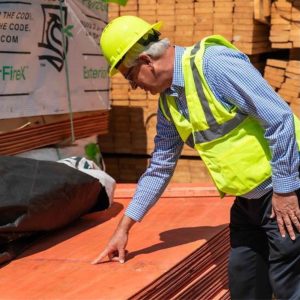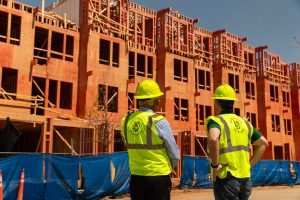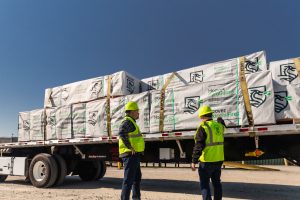As we move into 2025, simplifying safety for building professionals and the communities they serve remains a top priority for everyone at Hoover.
To support this mission, here are five key insights on how fire-retardant-treated wood (FRTW) aids in passive fire prevention, supports eco-friendly construction, promotes industry education and ensures code compliance to build safer, more resilient communities in the year ahead.
FRTW wood is key in passive fire prevention.
FRTW offers an effective way to mitigate fire risk, particularly in vulnerable areas where buildings are in close proximity to natural fire sources. These areas, called the wildland-urban interface (WUI), are especially important to build with FRTW as they have increased risk of wildfires compared to more urban areas.
Pressure-treated with fire-retardant chemicals, FRTW forms a protective char layer when exposed to heat, slowing the spread of fire without requiring active intervention. It’s also recognized in many sections of the building codes to be used in lieu of noncombustible materials, providing both safety and design flexibility. By incorporating FRTW, communities can minimize the impact of catastrophic fires, offering a cost-effective, reliable solution for fire protection.
Building with wood is a sustainable choice.
Wood is an environmentally sustainable building material that requires far less energy to produce compared to other building materials like steel or concrete, which involve more energy-intensive processes and higher CO2 emissions. Wood serves as a natural carbon sink, storing significant amounts of CO2 and helping to reduce the overall carbon footprint of construction projects. Incorporating wood into projects not only supports sustainability but also aligns with the architectural and construction industry’s broader commitment to reducing environmental impact and promoting responsible resource use.
Education leads to protecting lives.
Hoover recognizes the importance of educating architects, contractors and communities about the benefits of FRTW. Through services like TecWood, sales training modules and educational sessions led by experts, Hoover provides guidance on how to incorporate FRTW into any project. These initiatives help ensure compliance with safety standards and promote the use of FRTW as both a sustainable and fire-safe material, ultimately contributing to the protection of lives.
Code compliance strengthens trust.
Hoover’s commitment to code compliance strengthens trust with customers and industry partners. As the first FRTW producer to meet the updated 2024 International Building Code (IBC) requirements for fire-retardant-treated wood, Hoover emphasizes safety and reliability. This certification, achieved through partnership with Underwriters Laboratories (UL), underscores Hoover’s commitment to producing rigorously tested, high-quality products. Adhering to stringent standards ensures that Hoover’s solutions continue to offer industry-leading protection and peace of mind to customers.
FRTW is reliable.
FRTW is recognized by the building codes to be used in lieu of noncombustible materials in many areas, making it a reliable solution for fire safety. This designation ensures that structures incorporating FRTW can benefit from the same level of protection as those using noncombustible materials like concrete or steel. For architects and builders, this recognition provides both safety assurance and design flexibility. They can incorporate FRTW into various building applications while meeting strict fire safety standards, reducing fire risks and optimizing their designs without compromising on durability or functionality.



